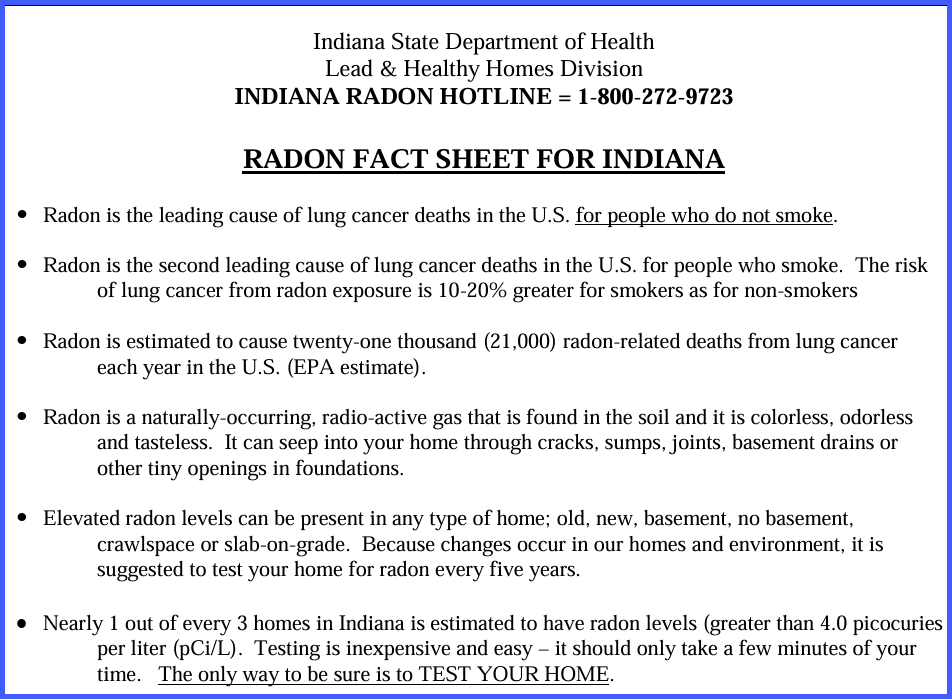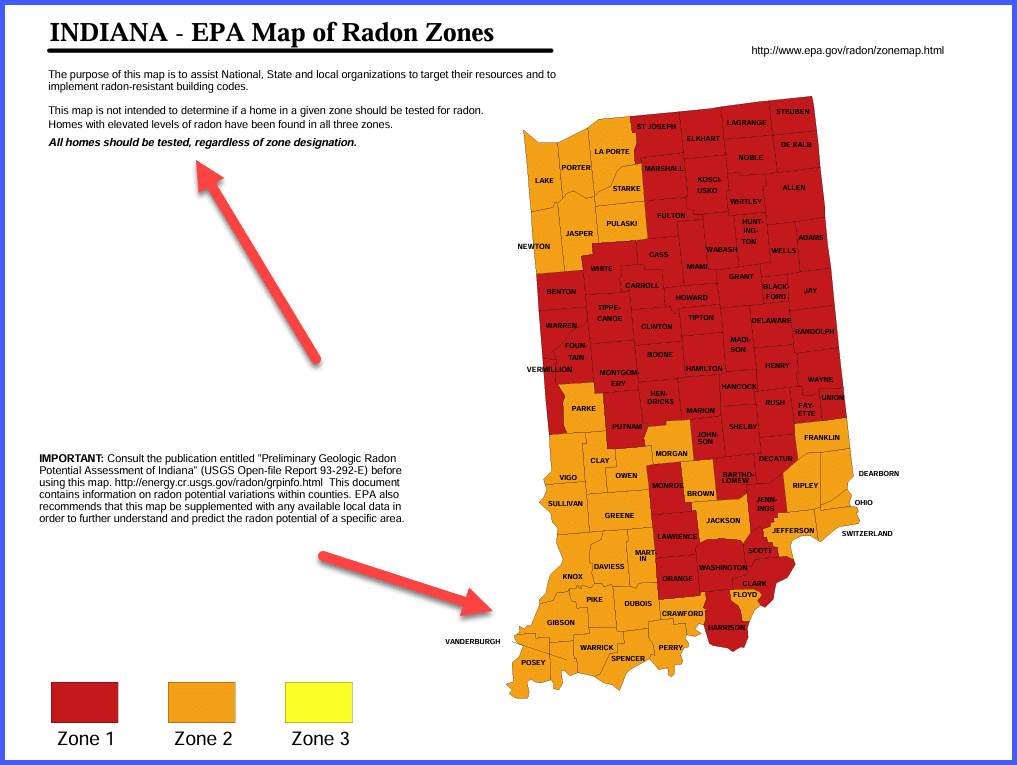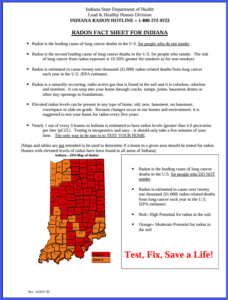
Below is a comprehensive guide on radon in our local Indiana communities. Enjoy a quick summary of key points below, and then read on for an in‐depth look at radon risks, testing, and mitigation:
Key Points
- Overview of Radon and Its Health Risks:
Understand what radon is and why it’s a concern in homes, especially in areas with elevated levels. - Local Radon Statistics:
Learn about the local five-county area surrounding Vanderburgh, IN, where approximately 20% of homes show elevated radon levels. That’s 2 in every 10. Looking for the shortcut? The bottom line of the EPA, Indiana State, and NRPP is that all homes in our area should be tested. - Entry Points in Homes:
Discover how radon can infiltrate a home via slabs, basements, and crawl spaces. - Testing & Certification Resources:
Refer to the National Radon Proficiency Program (NRPP) and other reputable sources. - Inspection Scheduling:
Get instructions on scheduling a radon inspection with Champion Property Inspection in Newburgh, IN. - Regulatory and Educational Resources:
Access the EPA’s Buyer and Seller’s Guide to Radon, the EPA’s Radon webpage, and the Indiana Radon website for state-specific information.
A copy of the multipage Indiana State Radon Fact Sheet.

Fact Sheet from the Indiana State Dept of Health
Read More Below
Understanding Radon Risks in Vanderburgh, IN, and Surrounding Areas
Radon is an invisible, odorless, and tasteless radioactive gas that forms naturally from the decay of uranium in soil, rock, and water. As it migrates from the ground, it can seep into homes through cracks in foundations, gaps around pipes, and other openings in slabs, basements, and crawl spaces. This guide will provide you with everything you need to know about radon, its potential health risks, how to test for it, and what steps you can take if high levels are detected—especially in the local five-county region surrounding Vanderburgh, IN, where our data indicates that about 20% of homes have radon levels that require attention. This aligns with the states information as well.
What is Radon and Why is it a Concern?
Radon is a byproduct of the natural breakdown of uranium and is present in varying amounts in soils across the United States. Because it is a gas, radon can travel through the soil and enter buildings, where it can accumulate. Long-term exposure to elevated radon levels has been linked to an increased risk of lung cancer—the EPA even estimates that radon is the second leading cause of lung cancer after smoking. For homeowners and prospective buyers alike, understanding radon and taking proactive measures to test and mitigate it is crucial for protecting health and ensuring a safe living environment.
Local Radon Levels: The Vanderburgh and Surrounding Counties Scenario
In the five-county area surrounding Vanderburgh, IN, approximately 20% of homes have been found to have radon levels that exceed the EPA’s action level of 4 picocuries per liter (pCi/L). This statistic is a reminder that even in communities with diverse housing stocks—from older homes with basements to newer builds with slab foundations—radon can be a hidden danger. Whether your home features a slab, a basement, or a crawl space, each type of foundation offers its own pathway for radon entry, making testing and mitigation a universal necessity.
This map was obtained from the EPA Indiana Radon Map.

How Does Radon Enter Your Home?
Slab-on-Grade Homes
Even homes built with a slab foundation can experience radon entry. Cracks in the concrete, gaps around service pipes, and construction joints are common entry points. As radon gas migrates from the underlying soil, these openings can allow it to seep into the indoor environment.
Basements
Basements typically have a larger surface area in contact with the soil and often feature more cracks and openings. Poor ventilation can allow radon levels to build up over time, making basements a common area for elevated radon concentrations.
Crawl Spaces
Homes with crawl spaces are also vulnerable. Radon can accumulate in these semi-enclosed areas, which might not be as well-ventilated or insulated as the main living spaces, and then make its way indoors.
The Importance of Radon Testing
Because radon is colorless, odorless, and tasteless, the only way to detect its presence is through specialized testing. Both short-term and long-term testing methods are available, and certified professionals can help determine the best approach for your specific situation. Many experts recommend long-term testing (over several months) for a more accurate assessment of average radon levels, while short-term tests can provide quick initial results.
Page 1 of 4, of the Indiana State Radon Fact Sheet

Indiana States Fact Sheet
Certified Testing and Mitigation Resources
- National Radon Proficiency Program (NRPP): Sets standards for radon measurement and mitigation professionals. Their website provides a directory of certified professionals and additional details on best practices in radon testing.
- Indiana State Compliance: Indiana is a licensed state that adheres to these standards.
- InterNACHI: The International Association of Certified Home Inspectors offers guidelines, training, and resources to help inspectors identify radon risks and recommend appropriate mitigation measures.
Additionally, for those interested in innovative radon detection technology, Air Things offers modern radon detectors that provide continuous monitoring and real-time data. By scheduling a test, you not only gain peace of mind but also take an important step toward safeguarding your home against radon exposure.
EPA Guidelines and Resources for Buyers and Sellers
Whether you’re buying a new home or selling your current property, radon testing should be part of your due diligence. The EPA’s Buyer and Seller’s Guide to Radon outlines the importance of testing during real estate transactions. The guide includes:
- Step-by-Step Testing Instructions: Clear guidelines on how to test for radon, which equipment to use, and how to interpret results.
- Mitigation Strategies: Recommendations for reducing radon levels if your home tests above the EPA action level.
- Disclosure Recommendations: Advice on how to disclose radon information in real estate transactions to ensure transparency and safety.
The EPA’s Radon webpage offers a wealth of additional information, including health risks, detailed mitigation techniques, and links to local resources.
Indiana-Specific Resources and Regulations
For homeowners in Indiana, staying informed about state-specific radon regulations and resources is crucial. The Indiana Department of Environmental Management (IDEM) provides valuable information regarding radon in homes through the Indiana Radon Program website. Here, you will find:
- State Guidelines and Recommendations: Detailed information on radon testing requirements and recommended mitigation techniques specific to Indiana.
- Local Resources: Contact information for local radon professionals and links to additional state-sponsored resources.
- Educational Materials: Brochures, fact sheets, and other documents explaining radon’s risks and the importance of testing and mitigation.
Additionally, checking Indiana State’s official website can provide a broader context on environmental health issues, including radon.
Mitigating Radon in Your Home
If testing reveals high radon levels, mitigation is essential. The most common mitigation strategy is the installation of a radon mitigation system, which typically includes:
- Sub-Slab Depressurization: Creating a vacuum beneath your home’s foundation to draw radon away from indoor spaces using a fan and a network of pipes.
- Sealing Cracks and Openings: While sealing alone may not significantly reduce radon levels, it is an effective supplementary measure when combined with a mitigation system.
- Improving Ventilation: Increasing natural or mechanical ventilation in your home can help dilute indoor radon concentrations.
It’s important to have a professional assess your home and recommend the most effective mitigation strategy. Certified radon mitigation professionals—often listed on the NRPP or InterNACHI websites—can provide the necessary expertise.
Taking Action: Protect Your Home and Health
Given the potential health risks associated with radon exposure, proactive measures are essential. Whether you’re a homeowner, buyer, or seller, understanding and managing radon levels is key to ensuring a safe living environment. Here are some immediate steps you can take:
- Schedule a Professional Inspection: If you live in the Newburgh, IN area or anywhere in the surrounding counties, consider booking a radon test with a certified professional. Visit Champion Property Inspection in Newburgh, IN for trusted local service.
- Consult EPA and State Resources: Familiarize yourself with the EPA’s Radon webpage and Buyer and Seller’s Guide to understand testing protocols and mitigation strategies. Also, explore the Indiana Radon Program website for state-specific information.
- Educate Yourself and Your Family: Use trusted resources like InterNACHI and the NRPP to stay informed about best practices in radon testing and mitigation.
- Monitor and Maintain: If a mitigation system is installed, regular maintenance and periodic radon testing will ensure that levels remain safe over time.
Final Thoughts
Radon is a serious yet manageable risk. With approximately 20% of homes in the local five-county area surrounding Vanderburgh, IN showing elevated levels, understanding radon’s impact and taking preventive measures is more important than ever. Whether your home features a slab, basement, or crawl space, radon can enter through various pathways and accumulate to dangerous levels if left unchecked.
By leveraging the expertise of certified professionals and utilizing trusted resources—such as InterNACHI, the NRPP, and the EPA’s radon guides—you can ensure that your home is both safe and compliant with local and state standards. Indiana-specific resources, including the Indiana Radon Program website, offer valuable insights tailored to our local needs.
For residents in Newburgh, IN, scheduling a radon inspection with Champion Property Inspection is a straightforward way to begin protecting your home. Regular testing and proactive mitigation are key to reducing the health risks associated with radon exposure.
Taking action today means safeguarding not only your property but also the health of your family. Stay informed, be proactive, and make radon safety a priority in your home.
How to Schedule a Radon Test with Champion Property Inspection
For residents in the Newburgh, IN area seeking professional radon inspection services, Champion Property Inspection offers comprehensive radon testing as part of its home inspection services. To schedule an inspection:
- Visit Their Website: Go to the Champion Property Inspection Newburgh, IN page to learn more about their services and available time slots.
- Call for an Appointment: Speak directly with a representative by calling (812) 639-3096.
- Online Booking: Many modern inspection services offer an online scheduling option, making it easier than ever to select a convenient time.
Stephen Rager is a licensed in Indiana Home Inspector, Licensed in Indiana Radon Measurement Professional, National Radon Proficiency Program Certified as a Radon Measurement Professional since 2018.
